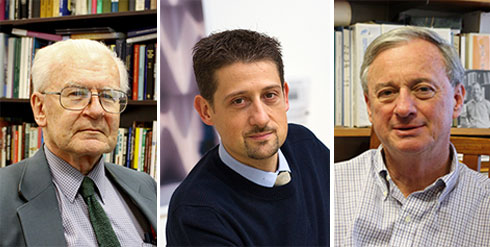MIT awarded over $1.7M in DOE Nuclear Energy University Programs grants and $450K in graduate student fellowships

Two of 47 newly-funded Department of Energy research projects are led by professors in the Department of Nuclear Science and Engineering at MIT. Under its Nuclear Energy University Programs (NEUP) umbrella, the DOE has awarded $36.2 million in support of projects in four fields: fuel cycle research & development; reactor concepts research, development & demonstration; nuclear energy advanced modeling & simulation; and transformative research. Both the MIT projects fall into the fuel cycle research & development category.
“Optimization of Deep Borehole Systems for HLW Disposal”, led by Professors Michael Driscoll and Emilio Baglietto, received an $850,000 grant; and “Scholarship for Nuclear Communications and Methods for Evaluation of Nuclear Project Acceptability”, led by Professor Michael Golay, received $800,000.
The objective of the “Optimization of Deep Borehole Systems for HLW Disposal” project is to provide a comprehensive evaluation of the deep borehole option for disposal of high level nuclear waste. This project builds upon a long history of prior work carried out in the Department of Nuclear Science and Engineering at MIT and more recently at Sandia National Labs. It is designed in part to respond to the recent report to the Secretary of Energy by the Blue Ribbon Commission on America’s Nuclear Future, which — drawing in part on earlier MIT research — identified deep boreholes as a possible alternative to shallower mined repositories.
Collaborators on this project are Professors Jacopo Buongiorno and Richard Lester at MIT, and Dr. Patrick Brady at Sandia National Labs.
“Scholarship for Nuclear Communications and Methods for Evaluation of Nuclear Project Acceptability" will develop a model to characterize the factors affecting social acceptance of nuclear projects by potential stakeholders. The nuclear enterprise has long faced difficulties in gaining the broad social acceptance needed for success. The base of scholarship relevant to this problem is relatively small, and not much used within the nuclear enterprise. Reliance upon public education efforts continues to be the main, and largely unsuccessful, tactic to achieve acceptance. This project will develop a model for the social acceptability of nuclear projects, for use in assessment and refinement of their probabilities of success among essential stakeholders. The researchers expect that it will strengthen the ability to design and implement large projects more efficiently, leading to higher rates of success for future nuclear projects.
In addition to the two research grants, three NSE graduate students, Sam Shaner, William Boyd and Bradley Black, have been awarded 2012 NEUP fellowships. Each student will receive $150,000 over three years to support their studies at MIT.
These grants and fellowships are part of a larger effort by the DOE to build on President Obama’s commitment to promote education in the areas of science, technology, engineering and math. The awards announced today under the Department’s NEUP programs will support nuclear energy R&D and student education at 46 colleges and universities around the country.
Related
- NSE graduate students Black, Boyd, Shaner win NEUP Fellowships
- New NSE strategy strengthens core, opens boundaries; seeks better integration of technical and societal issues
- New NSE faculty drive curriculum expansion into computational science and engineering
- Energy Department Announces New Investments to Train Next Generation of Nuclear Energy Leaders, Advance University-Led Nuclear Innovation
- NEUP 2012 R&D award abstracts
Photos
left to right: Michael Driscoll, Emilio Baglietto, Michael Golay
photos of Driscoll, Golay by
Despoina Chatzikyriakou
photo of Baglietto by Justin Knight
